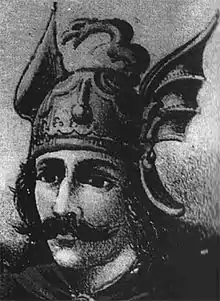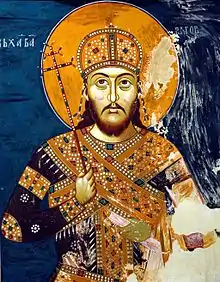Style of the Serbian sovereign
There has been many regnal styles of Serbian sovereigns.
Middle Ages
| Shortened style | Time |
|---|---|
| Prince of Serbia / the Serbs[a] | c. 960– |
| Grand Prince of Serbia / the Serbs / all Rascian lands[b] | 1112–1217 |
| King of Serbia / the Serbs[c] | 1217–1345 |
| Tsar of All Serbia, Bulgaria, Albania and Greece / All the Serbs, Greeks, Bulgarians, Vlachs and Albanians[d] | 1345–71 (–89) |
| Despot of Serbia / Rascia[e] | 1402–1543 |
 Prince Časlav
Prince Časlav_(%D0%BE%D0%BA%D0%BE_1113_-_1199).jpg.webp) Grand Prince Stefan Nemanja
Grand Prince Stefan Nemanja King Stefan Uroš I
King Stefan Uroš I Emperor Stefan Dušan
Emperor Stefan Dušan.jpg.webp) Despot Đurađ Branković
Despot Đurađ Branković
Modern
- "Prince of Serbia" (see Principality of Serbia), in use 1817–82
- "King of Serbia" (see Kingdom of Serbia), in use 1882–1918
- "King of Serbs, Croats and Slovenes" (see Kingdom of Serbs, Croats and Slovenes), in use 1918–29
- "King of Yugoslavia" (see Kingdom of Yugoslavia), in use 1929–45
See also
Annotations
- ^ "Prince (archon) of the Serbs" (αρχων Σερβλίας), according to De Administrando Imperio (960);[1] "Prince of Serbia", according to George Kedrenos (fl. 1050s);[2] "Prince of the Serbs" (ὁ τῶν Σέρβων ἄρχων), according to John Skylitzes (fl. 1057–59);[3] "Executor of Duklja and Serbia", in (1081–1118);[4][5]
- ^ "Grand Prince" (veliki župan), in the 11th and 12th centuries;,[6] before 1217;
- ^ "King of Serbia, Romans, Albania and the coast", in 1343;
- ^ "Tsar (Emperor) of the Serbs and Romans (Greeks)", in 1345; "Basileus (Emperor) and autocrator of Serbs and Romans (Greeks)" (Bασιλεὺς καὶ αὐτoκράτωρ Σερβίας καὶ Pωμανίας);[7] "Autocrator of all the Serbian land", in c. 1379–89.
- ^ "Despot of the Kingdom of Rascia and Lord of Serbia" (Stephanus dei gratia regni Rassia despotus et dominus Servie[8]), after 1402; "Despoth, Dominus Rasciae" in the founding charter of the Order of the Dragon (1408);.[9] "Despot of the Kingdom of Serbia and Lord of Albania" (Nos Georgius dei gracia Regni Rascie despotus et Albanie dominus and illustres principes, dominus Georgius, regni Rascie despotus et dominus Albanie);[10] "Prince, Duke and Despot of Serbia and Albania" (illustris princeps, dux et despotus totius regni Rascie et Albanie), by Sigismund in 1427;[11] "Despot and Duke of Serbia" (illustris Georgius despotus seu dux Rascie), by Sigismund in 1429;[12] "Lord of Serbia [and] Albania" (Georgius Wlk Rascie Albanieque dominus), in 1429;[13] "Lord, Despot of the Serbs" (gospodin Srbljem despot), by Constantine of Kostenets in 1431;[14] "Prince, Despot of the Kingdoms of Serbia and Albania" (illustrissimus princeps Georgius despotus regni Rascie et Albanie, Rive et totius Ussore dominus), in 1453.[13]
References
- Constantine VII Porphyrogenitus (Emperor of the East) (1920). The Early History of the Slavonic Settlements in Dalmatia, Croatia, & Serbia. Society for promoting Christian knowledge.
αρχων Σερβλίας
- Cedrenus, ed. Bonn, II, p. 526
- Scylitzes, 408-9
- "Jean-Claude Cheynet, "La place de la Serbie dans la diplomatie Byzantine à la fin du XI e siècle", Zbornik radova Vizantološkog instituta , XLV, Beograd, 2008, 89–9" (PDF). Archived from the original (PDF) on 2014-11-06. Cite journal requires
|journal=(help) - Predrag Komatina. "Vizantijska titula Konstantina Bodina (Byzantine title of Constantine Bodin)". Cite journal requires
|journal=(help) - Сима Ћирковић; Раде Михальчић (1999). Лексикон српског средњег века. Knowledge. p. 73.
ВЕЛИКИ ЖУПАН - 1. Титула српског владара у XI и XII веку. Гласила је велнм жупднк и била превођена одговарајућим терминима, грчки арџ- ^огтагот, игуа^огтауге, цеуаХа? ^огтожх, латин- ски те^ајирапиз, та§пиз ...
- Fine 1994, p. 309.
- Radovi. 19. 1972. p. 30.
Stephanus dei gra- tia regni Rassia despotus et dominus Servie
- Ekaterini Mitsiou (2010). Emperor Sigismund and the orthodox world. Austrian Academy of Sciences Press. p. 103. ISBN 978-3-7001-6685-6.
The first name to appear is Stephanus Despoth, Dominus Rasciae
- József Teleki (gróf) (1853). Hunyadiak kora Magyarországon. Emich és Eisenfels könyvnyomdája. pp. 243–.
- Denkschriften. In Kommission bei A. Hölder. 1920.
König Sigismund nennt ihn 1427 ‚illustris princeps, dux et despotus totius regni Rascie et Albanie'.2 In seinen eigenen ... nach Bestätigung des Despotentitels regelmäßi<r ‚Georgius dei gratia regni Rascie despotus et Albanie dominus etc.
- Monographs. Naučno delo. 1960. p. 188.
... jyrca 1429 г. издатом у Пожуну, kojhm крал» Жигмунд flaje деспоту (illustris Georgius despotus seu dux Rascie) у посед „Torbaagh vocata in comitatu
- Radovi. 19. 1972. p. 30.
Georgius Wlk Rascie Albanieque dominus [...] illustrissimus princeps Georgius despotus regni Rascie et Albanie, Rive et totius Ussore dominus
- Recueil de travaux de l'Institut des études byzantines. Institut. 2006. p. 38.
Further reading
- Svetislav Mandić (1986). Velika gospoda sve srpske zemlje i drugi prosopografski prilozi. Srpska književna zadruga.
У сво- јој држави, коју, из нашег времена посматрану, називамо Моравском Србијом, Лазар је, како кажу очувани документи из његовог доба, био велики кнез „всеје српскије земље", „всјем Србљем", или „Србљем и Подунављу",
- Vizantološki institut (Srpska akademija nauka i umetnosti) (2007). Zbornik radova.
(„краљ и самодржац Србљем и Поморју и Грком и Бугаром"); повеља цркви Свете Богородице Перивлепте у Охриду, од јесени 1345. („краљ свих српских и поморских и грчких земаља"); натпис у цркви Св. Ђорђа у Полошком, ...
This article is issued from Wikipedia. The text is licensed under Creative Commons - Attribution - Sharealike. Additional terms may apply for the media files.